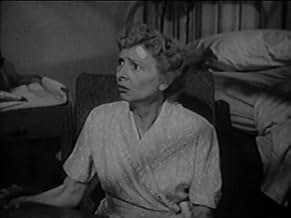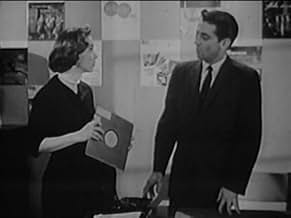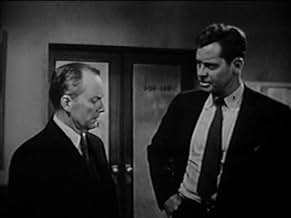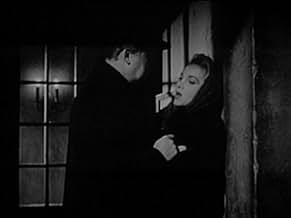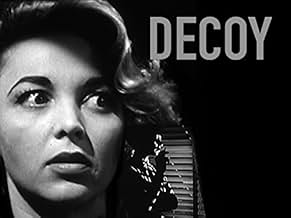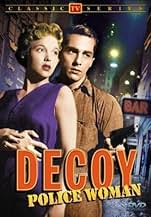Ajouter une intrigue dans votre langueNew York City policewoman Casey Jones' assignment to fight crime often entails her going undercover in some of the seediest and most dangerous parts of the city.New York City policewoman Casey Jones' assignment to fight crime often entails her going undercover in some of the seediest and most dangerous parts of the city.New York City policewoman Casey Jones' assignment to fight crime often entails her going undercover in some of the seediest and most dangerous parts of the city.
Parcourir les épisodes
Histoire
Le saviez-vous
- AnecdotesThe first cop show with a female protagonist.
- Crédits fousOpening credits include the dedication: "Presented as a tribute to the BUREAU OF POLICEWOMEN Police Department City of New York."
Commentaire à la une
Most lead characters on TV cop shows in the 1950s and 60s were guys. Decoy was a departure from the usual fare by casting Beverly Garland as Policewoman Casey Jones. Amazon Prime currently has all episodes available.
"Decoy," a title fitting perfectly with Casey's assignments, would have benefited with the more marketable name "Policewoman." Surprisingly the classictvhistory.wordpress blog only mentions Decoy once in an article about Brenner, another late-50s Manhattan-based crime show. It deserves a detailed analysis.
What I first noticed about Decoy is the performance by the great Beverly Garland and her sympathetic yet no-nonsense, duty-bound and calm characterization. There is no humor whatsoever in Decoy, not even fatalistic police humor or the sardonic closing line of a conversation that Jack Webb practically patented in Dragnet. In her narration, she accepts her job with a sense of pessimism about the worst qualities of human nature that she knows will continue to repeat. What real policemen and policewomen see and deal with everyday would break the average person.
Then there's the world Casey lives in, when police science technology was still fairly crude and a lack of knowledge by the TV writers about the physical reality of criminal acts, something that continues in today's TV and films. She relies on her intuition and her ability to influence criminals to accept her so she can find the evidence or get the confession that allows her to slap the cuffs on them. There's very little gun play and shootouts, no insane car chases or gun glorification that's filled TV screens for decades and there's not much physical violence, something that Angie Dickinson's Policewoman would make up for in the more permissive 1970s, adding sexual themes and an emphasis on Dickinson's sex appeal to the mix.
The black and white location shooting of New York City and outer boroughs, when the city was heading to a decline adds a huge downbeat, melancholy tone. The dirty streets, sense of decay and crumbling tenements that Naked City also captured (and Hawk did in color in the 60s) creates a moody, grim feel to Casey's thankless job. The threadbare, shabby studio sets, a standard in 50s TV, reinforces that atmosphere. The brief, opening theme music to Decoy is stock, used in several earlier movies, and creates a sense of impending doom that sets the pace.
Casey solves her cases with a sense of fatalism, knowing that solving a case doesn't close the book on the tragedy in the wake of a crime. Families are destroyed, reputations are tarnished.
Later on, Beverly Garland opened the Beverly Garland hotel in Studio City. I occasionally attended movie collectible shows at the hotel but never had the chance to meet her and get an autograph. Now called The Garland as of 2014, it was built by her second husband.
"Decoy," a title fitting perfectly with Casey's assignments, would have benefited with the more marketable name "Policewoman." Surprisingly the classictvhistory.wordpress blog only mentions Decoy once in an article about Brenner, another late-50s Manhattan-based crime show. It deserves a detailed analysis.
What I first noticed about Decoy is the performance by the great Beverly Garland and her sympathetic yet no-nonsense, duty-bound and calm characterization. There is no humor whatsoever in Decoy, not even fatalistic police humor or the sardonic closing line of a conversation that Jack Webb practically patented in Dragnet. In her narration, she accepts her job with a sense of pessimism about the worst qualities of human nature that she knows will continue to repeat. What real policemen and policewomen see and deal with everyday would break the average person.
Then there's the world Casey lives in, when police science technology was still fairly crude and a lack of knowledge by the TV writers about the physical reality of criminal acts, something that continues in today's TV and films. She relies on her intuition and her ability to influence criminals to accept her so she can find the evidence or get the confession that allows her to slap the cuffs on them. There's very little gun play and shootouts, no insane car chases or gun glorification that's filled TV screens for decades and there's not much physical violence, something that Angie Dickinson's Policewoman would make up for in the more permissive 1970s, adding sexual themes and an emphasis on Dickinson's sex appeal to the mix.
The black and white location shooting of New York City and outer boroughs, when the city was heading to a decline adds a huge downbeat, melancholy tone. The dirty streets, sense of decay and crumbling tenements that Naked City also captured (and Hawk did in color in the 60s) creates a moody, grim feel to Casey's thankless job. The threadbare, shabby studio sets, a standard in 50s TV, reinforces that atmosphere. The brief, opening theme music to Decoy is stock, used in several earlier movies, and creates a sense of impending doom that sets the pace.
Casey solves her cases with a sense of fatalism, knowing that solving a case doesn't close the book on the tragedy in the wake of a crime. Families are destroyed, reputations are tarnished.
Later on, Beverly Garland opened the Beverly Garland hotel in Studio City. I occasionally attended movie collectible shows at the hotel but never had the chance to meet her and get an autograph. Now called The Garland as of 2014, it was built by her second husband.
- jameselliot-1
- 18 mai 2019
- Permalien
Meilleurs choix
Connectez-vous pour évaluer et suivre la liste de favoris afin de recevoir des recommandations personnalisées
- How many seasons does Decoy have?Alimenté par Alexa
Détails
- Durée30 minutes
- Couleur
- Mixage
- Rapport de forme
- 1.33 : 1
Contribuer à cette page
Suggérer une modification ou ajouter du contenu manquant


